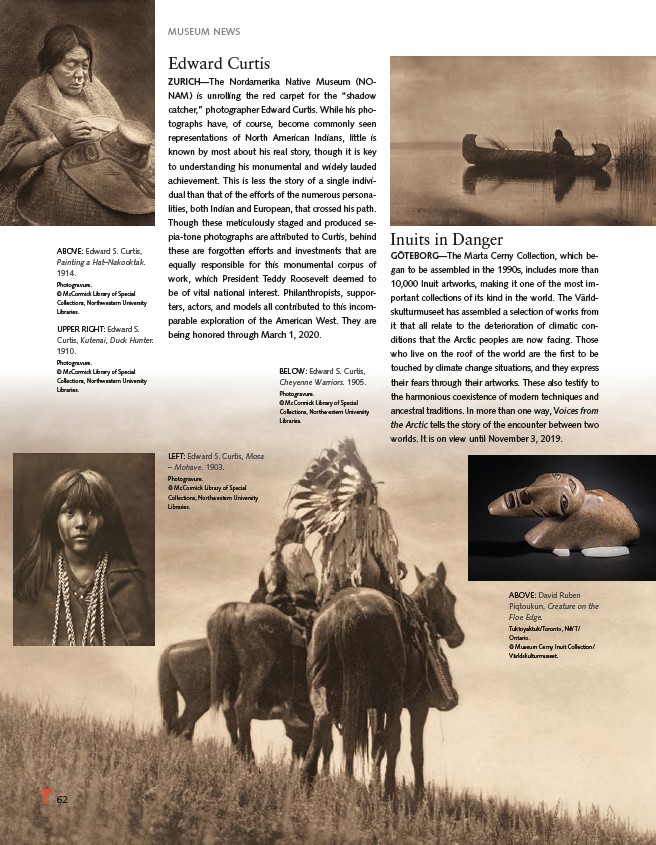
62
LEFT: Edward S. Curtis, Mosa
– Mohave. 1903.
Photogravure.
© McCormick Library of Special
Collections, Northwestern University
Libraries.
BELOW: Edward S. Curtis,
Cheyenne Warriors. 1905.
Photogravure.
© McCormick Library of Special
Collections, Northwestern University
Libraries.
Inuits in Danger
GÖTEBORG—The Marta Cerny Collection, which began
to be assembled in the 1990s, includes more than
10,000 Inuit artworks, making it one of the most important
collections of its kind in the world. The Världskulturmuseet
has assembled a selection of works from
it that all relate to the deterioration of climatic conditions
that the Arctic peoples are now facing. Those
who live on the roof of the world are the fi rst to be
touched by climate change situations, and they express
their fears through their artworks. These also testify to
the harmonious coexistence of modern techniques and
ancestral traditions. In more than one way, Voices from
the Arctic tells the story of the encounter between two
worlds. It is on view until November 3, 2019.
ABOVE: David Ruben
Piqtoukun, Creature on the
Floe Edge.
Tuktoyaktuk/Toronto, NWT/
Ontario.
© Museum Cerny Inuit Collection/
Världskulturmuseet.
ABOVE: Edward S. Curtis,
Painting a Hat–Nakooktak.
1914.
Photogravure.
© McCormick Library of Special
Collections, Northwestern University
Libraries.
UPPER RIGHT: Edward S.
Curtis, Kutenai, Duck Hunter.
1910.
Photogravure.
© McCormick Library of Special
Collections, Northwestern University
Libraries.
MUSEUM NEWS
Edward Curtis
ZURICH—The Nordamerika Native Museum (NONAM)
is unrolling the red carpet for the “shadow
catcher,” photographer Edward Curtis. While his photographs
have, of course, become commonly seen
representations of North American Indians, little is
known by most about his real story, though it is key
to understanding his monumental and widely lauded
achievement. This is less the story of a single individual
than that of the efforts of the numerous personalities,
both Indian and European, that crossed his path.
Though these meticulously staged and produced sepia
tone photographs are attributed to Curtis, behind
these are forgotten efforts and investments that are
equally responsible for this monumental corpus of
work, which President Teddy Roosevelt deemed to
be of vital national interest. Philanthropists, supporters,
actors, and models all contributed to this incomparable
exploration of the American West. They are
being honored through March 1, 2020.